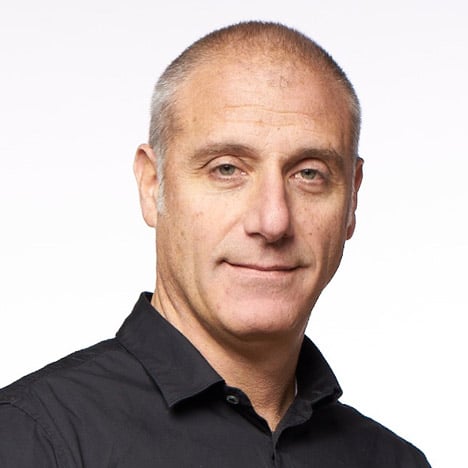
"Designers tend to be copycats," says Adidas global creative director
Interview: Paul Gaudio is Adidas' first creative director in 15 years, and a key part of the sportswear brand's strategy to use design as a weapon against arch-rival Nike. In this exclusive interview, Gaudio talks to Dezeen about Adidas' experiments in wearable technology, its collaboration with Kanye West and why copying is inevitable in sports design.
Gaudio – previously head of Adidas' Digital Sports division – is the first person in over a decade tasked with making everything designed by the German sports brand "look and feel and smell and taste like Adidas".
His appointment eight months ago as global creative director forms part of Adidas' ambitious plans to topple Oregon-based Nike as the dominant brand in the USA, where Nike products represent 59 per cent of trainer sales and Adidas just 10 per cent.
"We felt we needed to compete with design. That's a very clear aim. We expect to be the very best creative organisation on earth," Gaudio told Dezeen. "We want to challenge ourselves to take the brand somewhere new."
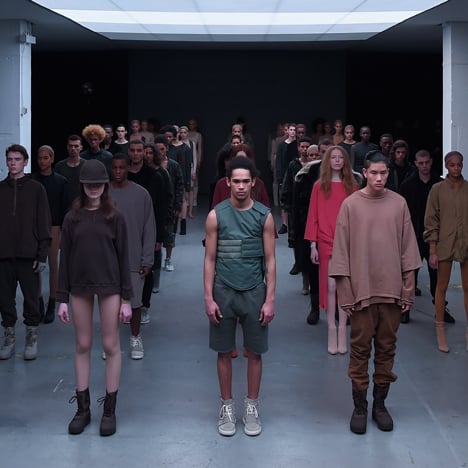
Gaudio's promotion followed the appointment of Eric Liedtke as executive board member for global brands, who told Dezeen he needed to "overcompensate in America from a design point of view".
In an effort to achieve this, last year Adidas poached three of Nike's senior design staff, and has moved Gaudio from its headquarters in Germany to its offices in Portland, Oregon, as part of the offensive.
He has now been tasked with creating a clear design thread that connects the work of over 500 creatives working across multiple departments and businesses. This encompasses the brand's fashion collaborations – including the range designed by musician and self-professed polymath Kanye West with Adidas' Originals brand – as well as a wide array of technical partnerships.
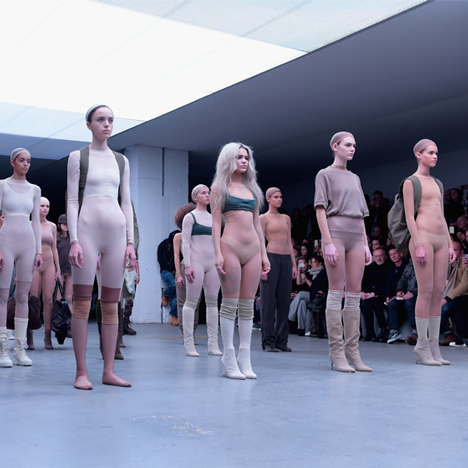
"Collaborations with people like Kanye, these tend to be things that we use to make statements to ourselves or to our consumers about who we are and what we can do," explained Gaudio.
"Of course we want to sell things, but not every product we make is equal," he said. "Some products are created to be huge, multi-million, commercial drivers, and others are made to set the tone, to put our flag out there and to make statements."
Gaudio describes the collaboration with West as part of Adidas' "open source" approach.
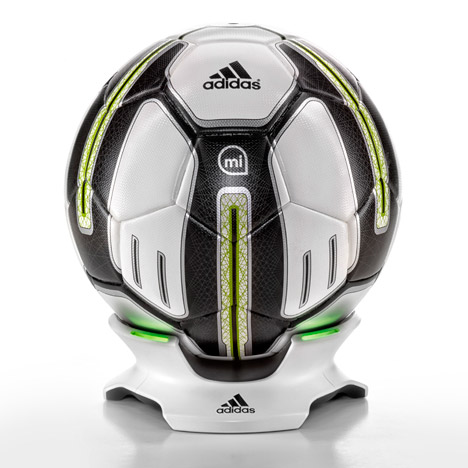
"We like to say we're like an open-source brand. We love to collaborate," he said. "We really like the idea that Kanye West, a huge celebrity, he wants to be creative, to do more than just make music. He is a creative force within himself."
"We provide a place for him to create and we become that facilitator, that output for his creativity," he added. "That's really the approach we take with everything, whether it's with other collaborations or whether it's how we work with our designers internally."
But there is a limit to how open he wants the brand to be. Like Nike, Adidas regularly pursues cases of copyright infringement, and the two brands are often at loggerheads. Gaudio says there is a difference between outright copying, imitation as a form of flattery and finding inspiration in other people's work.
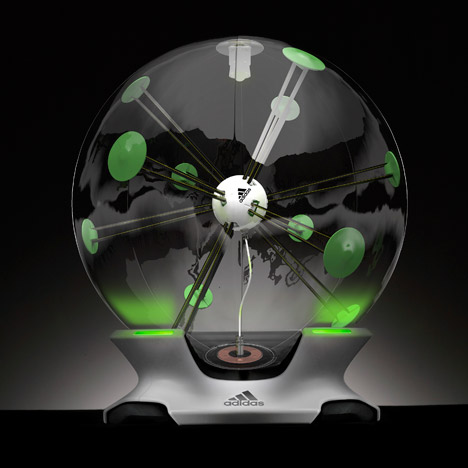
"We are definitely being knocked off around the globe and we don't appreciate it," he said. "When you are walking into a mall in Korea and you see a shoe that looks like yours but maybe has an extra stripe on it, I don't think that's something that anybody feels good about."
"At the same time, designers in general are... I don't mean it negatively, but we tend to be copycats. We see something that we love and it influences us," he added. "If there are things that look and feel similar, I don't see that as any kind of threat. That's the creative culture, driving the aesthetic of the industry forward."
Gaudio, who studied industrial design at Carnegie Mellon University in Pittsburgh, joined Adidas in 1992. By 1996 he was design director for Adidas America, but left the brand in 2000 to dabble in startup businesses and motorcycle design. He rejoined in 2006, and became head of Digital Sport in 2011, managing the interactive coaching programme miCoach for consumers as well as the brand's "elite" services for professional athletes.
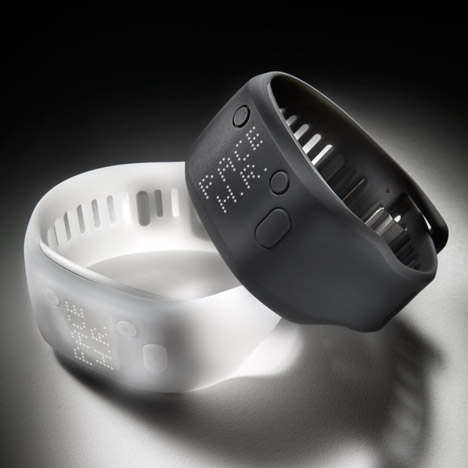
"We can essentially put sensors on athletes during their practice and get all their real time data back to the coach on the sideline to help them train," explained Gaudio. "That's the tip of our spear. That's our Formula One technology."
In 2013, his team launched the Smart Run, a bracelet device that connects to the miCoach training app and combines an MP3 player with various motion sensors to track performance and offer tailored coaching plans. This was followed last summer by the Fit Smart – Adidas' answer to wearable activity trackers like FitBit and Nike's FuelBand – which has been nominated for an IF Design Award.
"There are a lot of products on the market that go on the wrist and measure things. But they were very much lifestyle orientated," said Gaudio.
"We do things for people who, if not athletes, are at the very least are intending to use sport and fitness to reach their goals. So it's not really a watch. It's not an activity tracker or a piece of jewellery either. It's a sports product."
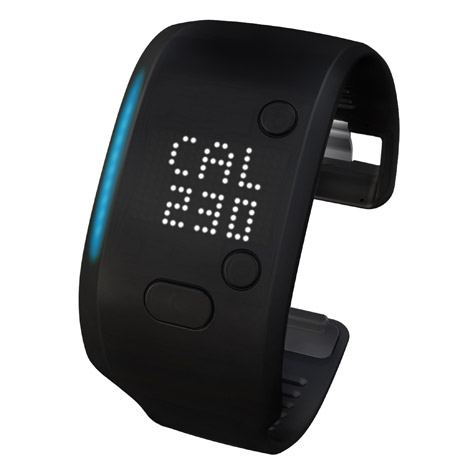
Gaudio's other major launch was the Smart Ball, a football that collects and tracks flight and impact data when kicked. The ball won an innovation award at the Consumer Electronics Show in January – one of the tech industry's most important events.
But according to Gaudio the next big leap for the sports industry will go beyond adding tech into existing products and wrist bands, and will fundamentally change the way Adidas operates.
"You will definitely see more innovations around what products are made of, how they get made, why they get made," he said.
"We see big changes coming, and I don't mean flying shoes. The industry is poised for a big change in how we create and how we build products and distribute products."
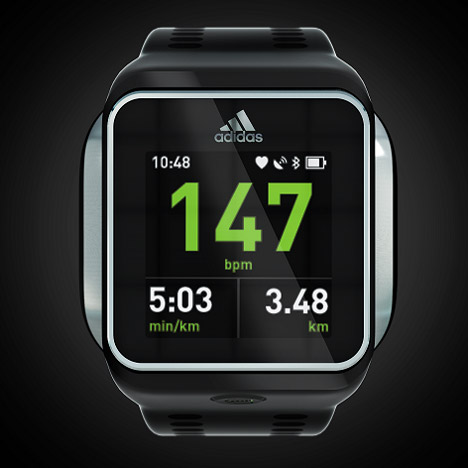
Read the edited transcript from our interview with Paul Gaudio:
Anna Winston: Tell me about your role at Adidas.
Paul Gaudio: I've been involved with with the brand for over 20 years in a lot of different functions. I started with brand innovation and product design, and then went off and did some startup things and some consulting and then came back to the brand. At that point it was more of a strategic role, looking at brand strategy and marketing. That, little by little, led me into the topic surrounding wearables and digital sports and the whole quantifiable self. Pushing the brand into that direction and ultimately, for the last few months, moving into my new role as the global creative director. The scope for that is... managing might be the wrong word, but leading the 500 or so creatives that we have around the world doing footwear design, apparel, hardware categories, retail and education design, branding, etc.
I'm an industrial designer and went to Carnegie Mellon University in Pittsburgh. I had forgotten completely about the brand, to be honest. I was out of school and was working as an industrial designer, and a friend of mine said "hey, I'm working there, what do you think?" and I said "what? really? I had kind of forgotten about you".
This was in the very early 1990s and he sent me some shoes, some really interesting shoes, that for the first time got me looking at athletic footwear, apparel and products as pieces of equipment that could help athletes get better. That is the core of the brand.
Anna Winston: How do wearable tech and responsive products fit into the bigger picture for Adidas?
Paul Gaudio: For me this was the most obvious step. If we are here to help people get better, then why don't we give them all the tools and information that they need to reach their goals, that they need to make their mark or whatever it is they are after; if they want to run a faster marathon, if they want to look or feel better, understand themselves better, manage their health better.
It was something that we jumped on very early. As a brand we started doing wearable technology as far back as 1980 with the micro-pacer, the first running shoe that could track your distance. It had a pedometer on board, built in. And that had never been done before.
So for us it has been a natural progression. We believe that technology can help people be better, or at least turn the lights on and help them reach their goals and change their behaviours. There was a huge wave that came and we were fortunate to see that coming and to understand it.
Anna Winston: Could you talk me through the thinking behind the FitSmart?
Paul Gaudio: There are a lot of products on the market that go on the wrist and measure things. Some are more successful than others. But they were very much lifestyle orientated – more for people who are looking to get credit for movement and trying to live a healthier life. That's all very good. But we wanted to take a different point of view.
We do things for people who, if not athletes, are at the very least intending to use sport and fitness to reach their goals. So it's not really a watch. It's not an activity tracker or a piece of jewellery either. It's a sports product. It's something that we designed to be used when you are working out, when you are sweating. And that obviously drives the whole function and form of the product because it's got to be low profile, it's got to be strong. We want it to look strong and powerful, easy to use and all of those things. That's very much why it looks like it looks. It's a very simple little design. But that is important when you are doing sports because you just don't want to be bothered by things.
Anna Winston: People are quite familiar with the idea of wearing something on their wrist to track behaviour. A football seems less obvious.
Paul Gaudio: This came out of our miCoach elite training system – we can essentially put sensors on athletes during their practice and get all their realtime data back to the coach on the sideline to help them train their athletes, manage the athletes and help them understand what they are going through, the process of training and fitness. That's the tip of our spear. That's our Formula One technology.
All of those sensors that we have developed to sense the body's movement with super sophisticated algorithms, can also track the play of the ball. Athletes and coaches want to know everything, and they want to track the ball. So we followed that and pretty quickly it went straight to a prototype. When we started playing with it and sharing it with consumers, pro-athletes and kids alike would just light up every time they got a chance to kick it. So we thought "hey this is great, we should market this".
Anna Winston: Do you approach these products as technology or product design? Where do they sit?
Paul Gaudio: We have a digital sports team that we set up over the last five or six years, with a combination of industrial designers and user experience designers. We have technical teams, we have mechanical engineers, we have electrical engineers, we have software folk. So we have built a full-service hub inside of the company that bridges the gap. Part of it is integrating our sensor technology into our footwear and apparel, and part of it is the hardware components that become wearable.
Anna Winston: How does what they do relate to what's going on in the rest of the company? The work that Adidas Originals is doing, for example, seems quite separate.
Paul Gaudio: Well for example when we develop something, say the miCoach Elite System, we do that in partnership with the businesses and experts around football. When we developed the wrist-based training devices we worked with our running businesses and our training businesses to get the insight into the consumer, to work on how we bring the product to market, how we make sure we integrate that into our overall story of the brand. Likewise, if we are offering things like apparel that allows sensors to be carried, or products that allow sensors in footwear to communicate back to the user in some way, we do that in a partnership. We are kind of in the middle.
Anna Winston: How do you develop a consistent design language for 500 creatives working in multiple different businesses and development areas within the brand?
Paul Gaudio: That's why we go to work everyday – not to be too flippant. We haven't had a global creative director here at Adidas for 15 years, so the reason in part for me being here is to make sure we can bring those things together and have a connective tissue and fingerprint that consumers can start to feel and understand, regardless of what market they are in, what retail format they might walk in to, what product they might pick up. Any experience they might chose to partake in, it should look and feel and smell and taste like Adidas. That's really why I am here.
We have processes and structures and calendars and all the usual things that big companies have to co-ordinate, but creative direction is kind of the starting point for everything. The creative teams, the 500 or odd people who are out there, they bring work to life. But my focus and the focus of our creative leadership team is the "why". Why are we doing it and how should we be doing it. How does our brand want to behave and act and look and feel.
Anna Winston: Why are you the first global creative director for 15 years? That's quite a big gap.
Paul Gaudio: I can't really answer that. Obviously the company goes through different organisational changes and priorities over time. As we started to look at what we needed to do in order to compete, we felt we needed to compete with design. As a creator of brands, we feel that we need to be the best. That's a very clear aim. We expect to be the very best creative organisation on earth.
We're a big team of people and we have a lot of very talented and diverse creatives across the planet and so we want to set very high expectations for ourselves and we want to challenge ourselves to take the brand somewhere new.
Anna Winston: Aside from sales, how do you judge that something has strategically been a success in design terms?
Paul Gaudio: Collaborations with people like Kanye, these tend to be things that we use to make statements to ourselves or to our consumers about who we are and what we can do. Statements of leadership and statements of creativity. So we measure ourselves by the reactions and response of our consumers. Yes, there's the direct sales aspect of it, but we also look at what people are saying about us. In my mind to be the best, people have to say you were the best. That is the measure. When we get that feedback from consumers and from the culture around us, then we consider it a success.
Of course we want to sell things but not every product we make is equal. Some products are created to be huge, multi-million, commercial drivers, and others are made to feed and to set the tone, to put our flag out there and to make statements.
Anna Winston: You've only been in this role for eight months. Were you very involved in the Kanye West collaboration?
Paul Gaudio: It's been around for quite a while. I've become connected to it like everything else in the company now. As a brand we are very collaborative. We like to say we're like an open source brand. We love to collaborate. We don't see ourselves as limited or exclusive or narrow.
We really like the idea that Kanye West, a huge celebrity, he wants to be creative, to do more than just make music. He is a creative force within himself. We provide a place for him to create and we become that facilitator, that output for his creativity. That's really the approach we take with everything, whether it's with other collaborations or whether it's how we work with our designers internally.
Young people, young designers, come to Adidas because they know they can create. That they are able to chase and fulfil their creative dreams and visions. That is the same if I bring a software engineer in and he fantasises about working on the next wearable technology, or a young fashion designer from Paris who saw the Kanye show and was blown away by it. We welcome all. Our doors are open and our brand is open. That's really what it is about.
Anna Winston: Are there still boundaries between sports clothing, everyday clothing and high fashion?
Paul Gaudio: I think they have dissolved. They started dissolving back in the 1970s, when people started wearing Adidas trainers with jeans. The consumer just says "hey, that's something I want to wear. That is something I want to associate myself with. That's something I like".
Clothing, footwear, fashion – whether you are playing sport or going to school – are very intimate statements that you are making. And I think people make those decisions universally now. But Adidas still comes from sport. The fabrics, they might come from high-end basketball uniforms for example. That crossover is something we are going to continue to push and to drive.
The culture of sport has influenced everything. The most popular people on earth are athletes. People that aren't athletes want to associate with athletes. The entertainers and the athletes, that whole culture has come together and therefore codes around those cultures and the fashions and uniforms have blended into a mishmash. So we have things that are built for hardcore performance and they are going to be always super sharp and pure and simple – built for the Olympics or built for a marathon or built for jumping higher or running faster. But then everything kind of drafts off of that, all the way down the hallways, through to the street and onto the catwalk. We may stretch it into fashion, we may stretch it into the street, but sport is the foundation of it. And I think that is unique. The fashion guys don't come from sport. We do.
Anna Winston: Is copying an issue for Adidas?
Paul Gaudio: Yes. We are definitely being knocked off around the globe and we don't appreciate it and we don't let it expand. The products we design and create are the results of our obsession and passion and handwork and when you are walking into a mall in Korea and you see a shoe that looks like yours but maybe has an extra stripe on it, I don't think that's something that anybody feels good about. What I will say though, is that I think the idea of sharing and being open for co-creation, that's a different story. And I think that imitation is flattery and I am happy to see that part of it.
At the same time, designers in general are… I don't mean it negatively, but we tend to be copycats. We see something that we love and it influences us. It's a natural part of the creation process. So if there are things that look and feel similar, I don't see that as any kind of threat. That's the driving creative culture, driving the aesthetic of the industry forward and I think that's a normal part of it.
Anna Winston: What's the next step for sportswear, beyond the current wave of wearable tech?
Paul Gaudio: Obviously I can't pull back the curtains all the way, but we see big changes coming, and I don't mean flying shoes.
The industry is poised for a big change in how we create and how we build products and distribute products, and we are excited about our place in that. Right now, the space is very narrow. With apparel, it's clothing, it's stuff that you stitch and sew. The innovations are not always within the actual product, they are around the product. You will definitely see more innovations around what products are made of, how they get made, why they get made.
We are not stopping, we are not taking our foot off the gas. We are very excited about what we can bring next.